I originally thought the equation was arbre = tree, arbuste = shrub and buisson = bush. Well, I was wrong. The first time I saw a lilac bush, I thought it was a tree. It looked like a tree to me and certainly not like a bush (a lot of the flowers are way above my head), but when I used the word arbre I was immediately corrected. Non, c’est un arbuste.
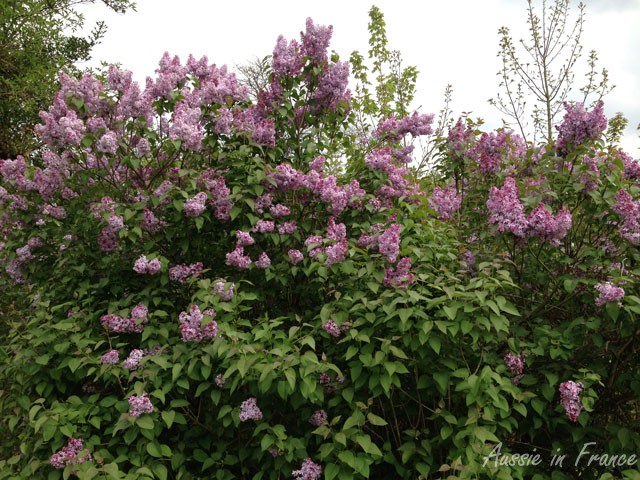
With the arrival of spring, there are lots of flowering shrubs, so I asked Jean Michel to define arbuste for me. “Un petit arbre“, he replied. “No it’s not.” I replied, “You could call a young conifer un petit arbre but it still wouldn’t be an arbuste.” So I checked my Larousse app. An arbuste is a woody perennial plant less than 10 metres in height whose branches don’t grow from the base.
Then it says in brackets that a young arbuste looks like an arbrisseau (oh dear, I hadn’t even thought of that one !) then starts looking like a tree when it loses its lowest branches.
An arbrisseau has branches coming from the base and doesn’t grow more than 4 metres high. No examples given for either of course.
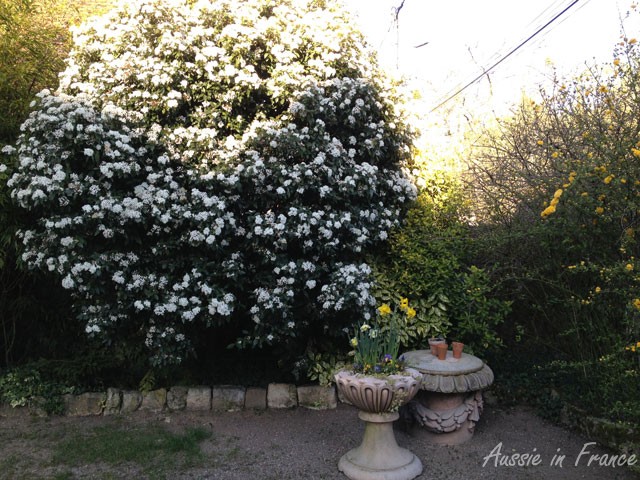
According to my Longman Dictionary of Contemporary English, a shrub is a small bush with several woody stems. A bush is a plant with many thin branches growing up from the ground.
Guess what an arbre is ? A woody perennial plant with branches that grows to at least 7 metres (where did they pull that one from?) and has permanent branches that only start a certain distance from the ground. It’s all relative, isn’t it ?
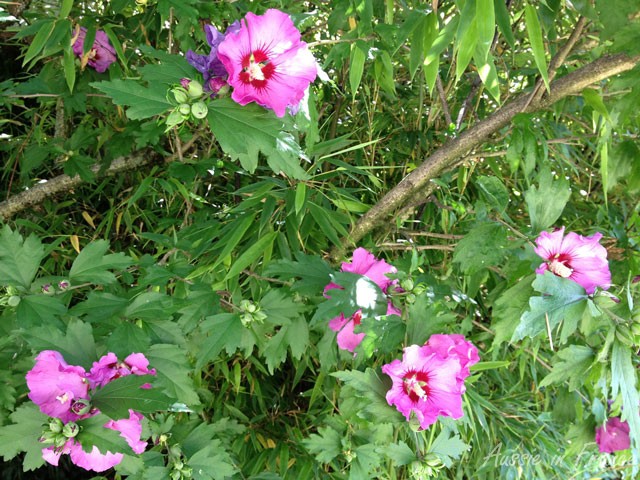
A tree is a very tall plant that has branches and leaves and lives for many years, to quote the Longman. That’s a definition? “Very tall”? “Many years”? Hardly precise.
I then consulted my New Shorter Oxford in two volumes just in case it’s more cluey. Well, it’s not. A bush is a shrub or clump of shrubs with stems of moderate length. A shrub is a woody plant, smaller than a tree. A tree is a woody perennial plant, typically having a single stem or trunk growing to a considerable height and bearing lateral branches at some distance from the ground.
But listen to the next bit : More widely, any bush or shrub of erect growth with a single stem. Which explains my confusion between trees, shrubs and bushes!
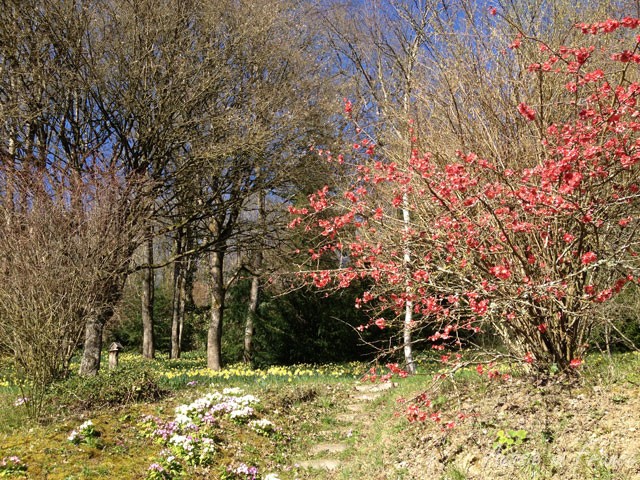
I went through a few plants with Jean Michel to see what category he would put them in. Let’s see. Lilac is an arbuste, Japonica quince is either an arbuste or an arbuste buissonnant. Oh no, not something else! I’d forgotten about buisson.
The Larousse says it’s an arbuste or group of arbustes with branches growing up from the ground and is difficult to get through. Hey, that sounds like a hedge, doesn’t it ? I thought hedge was haie. Haie is a line of arbres or arbustes forming a limit between two parcels of land. A hedge is a row of small bushes or trees growing close together, usually dividing one field or garden from another. So we can safely say hedge = haie.
I think we’ll just have to forget about the English and concentrate on the correct words to use in French, don’t you ?
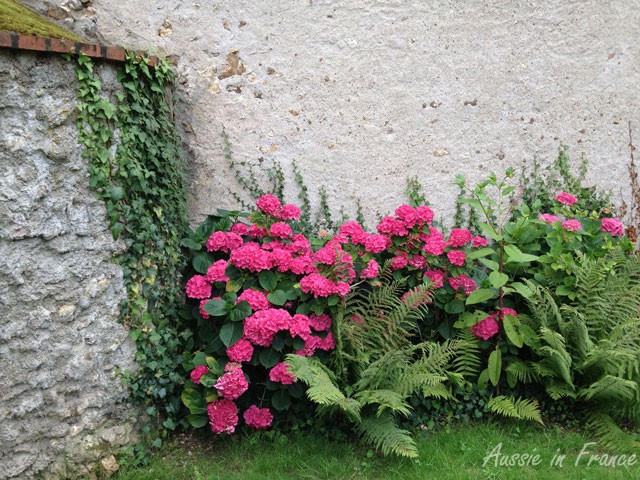
So, an arbuste looks like a tree only it’s smaller and has low-growing branches e.g. a lilac bush or a holly bush. An arbrisseau has branches growing up from the ground e.g. viburnum tinus (laurier tin), only no one ever says arbrisseau so we can call them arbustes as well, like Japonica quince (cognassier du Japon) and weigela or arbustes buissonnants or even buissons if they are small enough and are trimmed to form a hedge.
If you want to say arbre, check the plant is at least three times your height and has no low branches!





Word wizard Rosemary, humour me please. Seems to be a galloping epidemic of internet confusion over the use of verbs ‘lose and loose’.
You mention in your post: “like a tree when it ‘looses’ its lowest branches”. Do you mean ‘loses’ (verb to lose) or loose(n)s or is it a typo?
You would agree that a ‘loose’ woman is a salope, meaning immoral.
We may ‘loosen’ up a tight-fitting garment for comfort.
The window is ‘loose’ and so is my tooth. Loose is the opposite of tight.
Easy to ‘lose’ one’s temper over a dilemma with arbre, arbuste, buisson, arbrisseau?
You may ‘lose’ the struggle with Larousse and suffer a loss or you could loosen up the limits of their devilish gardening plot.
Lose sounds like ‘OOZ’ & Loose rhymes with ‘goose’. This or that person has a screw loose & may lose their marbles!
Fr. perdre = to lose. What would you choose to use for translation of ‘to loosen’ in french? Much obliged & thank you.
Hi Emerald, it’s a typo, I assure you! And I shall fix it up immediately. “Loosen” is interesting because its equivalent in French will vary according to context. I loosened my shoes = j’ai desserré mes chaussures; she loosened her shoelaces = elle a défait ses lacets; he loosened the rope = il a relâché la corde. But “loosen up the limits” is a bit trickier because I’m not sure you can loosen up the limits of a plot :), particularly with its two meanings! However, I found another example on the net: Try to loosen up the limits that you impose upon your mind. Perhaps “assouplir les limites” in this case as in the sentence La France va devoir assouplir les limites d’achat de tabac à l’étranger.
Definitely worth exploring!
You have of course made my brain explode. This comes under the category of stuff you just have to know, in both French and English. JM ‘just knows’ how to categorise the plants you ask him about into abres, arbustes et buissons, I would ‘just know’ how to do the same in English. It’s a product of growing up with plants people (gardeners, botanists) — you absorb the information by osmosis.
However, I think you have ultimately clarified the situation for me. In the past I would have simply split woody plants into arbres and buissons in French, and treated shrubs and bushes as either buissons if they were low and/or dense or petit arbres if they were more open. I knew the word arbuste, but would have forgotten to use it. Now I can see a clear link between arbre=tree, arbuste=shrub, buisson=bush.
Do you want me to ask some of my botanist friends if they have a contribution to this discussion (some examples, a simple definition?) The friend who would have been the most help, the ex-head gardener of the Parc Floral de Paris, sadly died a couple of years ago. He would have been delighted to help with this connundrum and is greatly missed by all who knew him. Warning: it may just open up a whole can of worms with so many ifs and buts that we may wish we hadn’t asked.
Part of the reason for the confusion, in both languages, is that the differences are conventions established by gardeners rather than botanists I think (and the plants themselves didn’t get the memo, so there are always exceptions to catch you out).
Just to be picky: Lilac is a shrub, but can be referred to in English as a tree, bush or shrub depending on context, with shrub being the most technical term and tree or bush being the lay term. Holly is definitely a tree in the wild, but can be pruned to be much smaller or even into a topiary shape, and there are smaller garden cultivars, in which case it might be referred to as a bush by gardeners and a shrub by professional gardeners.
I know what you mean about your mind exploding!
It would be very interesting to hear what the specialists have to say though I think the botanists would probably use the terms correctly. It’s what the lay person uses that poses the most problem. We have a holly tree that was replanted from the wild and its branches are too low to be an “arbre”. I wanted to post a photo but couldn’t find it!
Glad it’s cleared things up for you.
I’ve just checked the glossaries of various gardening and botanical books. Only Stace (the current taxonomical bible for British wild flora) bothers to define ‘shrub’ (a woody plant that is not a tree) and ‘tree’ (a woody plant 5m or more with a single trunk). ‘Bush’ doesn’t appear in the glossary at all, which suggests it is a gardening term that has no botanical validity ie it’s a convention to allow gardeners to distinguish between big and small shrubs basically. It is clear that one is just supposed to know all this stuff (and as a result the definitions are fairly fuzzy).
It love the “woody plant that is not a tree” which is about as tautological as you can get. I actually found lilac described on on-line nursery sites as bush, shrub and tree.
I didn’t mention that “bush” in Australia has five different meanings connected with vegetation: 1) a woody plant, esp. a low one, with many branches which usually arise from or near the ground. 2) Bot. a small cluster of shrubs appearing as a single plant. 3) Geog. a stretch of land covered with bushy vegetation of trees. 4) the countryside in general, as opposed to the towns. 5) bush house: a small garden shelter in which plants being cultivated are protected from wind and weather, usually with roof and sides thatched with dead native foliage. My mother grew orchids in her bush house. My source is the Macquarie Dictionary.
On the face of it Stace’s definition of a shrub is unhelpfully circular, however, the thing I know about Stace is that he is always absolutely precise. So — if a woody plant is not both 5m or more tall and with a single trunk, it is a shrub. Thus, a plant with multiple trunks that is more than 5m tall is a shrub, one with a single trunk but under 5m is also a shrub. It helps if you are used to working with dichotomous keys to identify species, because you recognise this sort of statement. Anybody using Stace is a professional level botanist and would have no problem with it.
Thank you Rosemary for those variations of language construction in your excellent reply. Lots of fascinating arboreal information arising from your Friday discussion. Osmotic tuning is now the modus operandi necessary. Do you have a Lilac growing in the Blois Garden?
You’re welcome! We have a lilac sort of growing in our little wood but this lilac is just across the road in the vacant area between us and the Loire so we can see it from our upstairs windows and whenever we go out the gate. So it’s sort of ours!
Hi Rosemary… Still coming here every friday but not much time left to comment.
On this matter (trees) I like your point (as usual) and the comparison you make between french and english languages but I have to say that when it comes to the scientific definition of words (if and when there is one) one should not worry too much… as even the locals don’t necessarily have the education (and/or any sort of interest) in naming things according to the scientific definition of the word itself… Not to mention the fact it might upset the locals when a foreign person can be seen as trying to teach them their language (I have experienced that first hand myself 🙂 )
In everyday’s french “un arbre” is what you call a tree (it has a trunk and above a certain height there are branches), and un buisson is what you call a bush. Un arbuste is a small tree(yes JM despite being wrong is very right!), abrisseau is rarely used at all. Of course if you talk with a gardener or a botanist theses differences in the definition will count.
This happens in most languages: Some words have both a “common sense” definition and a very technical one that can be ignored by most of the population… So… good to know but not too much focus on the matter 🙂
Voilà ! and I wish everybody here a very nice weekend indeed!
Ah, I thought maybe we’d lost you! So glad to hear you’ve been busy though. That can only be positive for business.
Don’t worry, I’m very careful about trying the locals their own language. I quite agree that arbrisseau is hardly ever used but the distinction is certainly made between arbre and arbuste while in English we call a lot of arbustes trees. Whence the confusion. It’s interesting to see how popular use develops, isn’t it?
I’m working on a botanical translation from French to English and that’s how I came across your blog. Love it! Thanks for the language explanations as well as the insights into your life. As a Romanian living in Vanuatu with a French partner and Aussie friends, I enjoy the mix of both cultures and have found your posts very entertaining 🙂
Hi Dana and welcome to Aussie in France. You certainly are a mixture! And I’m delighted to know you find my posts entertaining.